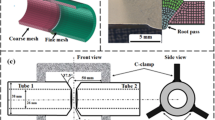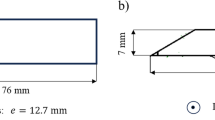Abstract
The failure of railway tracks is an unavoidable phenomenon that affects the operation intensively. Previously different failure assessments and investigation research have been carried out; however, failure investigation techniques need to be updated frequently and assessed because the problem still exists. “Failure mode, effects, and criticality analysis” (FMECA) were implemented to identify the most critical failure mode with higher risk. The welded rail specimens’ quality, hardness, and microstructural features were evaluated at different cooling rates experimentally. To identify and assess the microstructure feature and hardness of rail welding through different cooling mediums three major NDT tests have been employed. Generally, all the nondestructive test results demonstrate that there is a noticeable defect on the welded rail cooled at 6 °C/s. Comparatively fewer defects were observed on the welded rail cooled at 3 °C/s, while acceptable defects were manifested on the one cooled at 2 °C/s. from “Failure mode, effects, and criticality analysis” (FMECA) results “gauge corner spalling” failure mode was with the highest risk priority number so its improvement has a great influence on the maintenance efficiency. As a conclusion, cooling of rail welding’s at 2 °C/s cooling rate will give the material good microstructural feature and better weld quality relatively. Finally, the researcher suggests that the one working in the field can control the cooling rate of the weld for welding quality improvement and maintenance efficiency increment.











Similar content being viewed by others
Data Availability
Some of or else the entire data, figures, or models that are backing the discoveries of this study are available as of the corresponding author by reasonable inquirers.
Change history
03 October 2023
A Correction to this paper has been published: https://doi.org/10.1007/s11668-023-01779-5
Abbreviations
- AALRTS:
-
Addis Ababa Light Rail Transit Service
- WCZ:
-
Weld center zone
- TMAZ:
-
Thermo-mechanically affected zone
- HAZ:
-
Heat-affected zone
- BM:
-
The base material
- LFW:
-
Linear friction welding
- CGHAZ:
-
Coarse-grained heat-affected zone
- NDT:
-
Nondestructive test
- DB:
-
Decibel unit
References
H. Aglan, T. Rahman, Effect of preheating temperature and cooling rate on the microstructure development of welded pearlitic rail steel. Microsc. Microanal. 26(S2), 2662–2663 (2020). https://doi.org/10.1017/s1431927620022357
Anon, “Development of heat-treating type high strength rail production system,” Res. Dev. Japan Award. Okochi Meml. Prize, pp. 78–85, 1987, [Online]. Available: https://www.scopus.com/inward/record.uri?eid=2-s2.0-0023458815&partnerID=40&md5=d6b12657c18119922bd48c9baa08328d
D. Bajic, G. Vladimirovich Kuzmenko, I. Samardzic, Welding of rails with new technology of arc welding. Metalurgija. 52(3), 399–402 (2013)
R. Baptista, T. Santos, J. Marques, M. Guedes, V. Infante, Fatigue behavior and microstructural characterization of a high strength steel for welded railway rails. Int. J. Fatigue. 117, 1–8 (2018). https://doi.org/10.1016/j.ijfatigue.2018.07.032
N.S. Tsai and T.W. Eagar*, Selection of Processes for Welding Steel Rails, in Railr. Rail welding, Railw. Syst. Manag. Assoc., Northfield, NJ, 421 (1985)
D.M. Fegredo, W.A. Pollard, E.F. Connors, D.R. Kiff, The end-quench as a screening tool for controlled cooling of hot-rolled plates of potential premium rail compositions. Can. Metall. Q. 22(4), 453–473 (1983). https://doi.org/10.1179/cmq.1983.22.4.453
M. Ghazanfari, P. Hosseini Tehrani, Investigation of residual stress and optimization of welding process parameters to decrease tensile residual stress in the flash butt welded UIC60 rail. Based Des. Struct. Mach. Mech. (2020). https://doi.org/10.1080/15397734.2020.1756845
R. Guan, C. Ji, T. Chen, M. Zhu, H. Li, Formation mechanism of abnormal martensite in the welded joint of the bainitic rail. Metall. Mater. Trans. B Process. Metall. Mater. Process. Sci. (2021). https://doi.org/10.1007/s11663-021-02250-2
A.R. Khan, Y. Shengfu, H. Wang, Influence of heat input and preheating on microstructure and mechanical properties of coarse grain heat-affected zone of metal arc gas-welded pearlitic rail steel. J. Mater. Eng. Perform. 28(12), 7676–7686 (2019). https://doi.org/10.1007/s11665-019-04486-1
A.R. Khan, S. Yu, H. Wang, Y. Jiang, Effect of cooling rate on microstructure and mechanical properties in the CGHAZ of electro slag welded pearlitic rail steel. Metals (Basel). (2019). https://doi.org/10.3390/met9070742
N.A. Kozyrev, R.A. Shevchenko, A.A. Usol’tsev, A.N. Prudnikov, L.P. Bashchenko, Development and modeling of differentially heat-strengthened rail welding: welding and local heat treatment modeling. Steel Transl. 50(3), 139–145 (2020). https://doi.org/10.3103/S0967091220030067
X. Li, “Research on weldability of U71Mn and 74SiMnV rail steel,” Kang T’ieh/Iron Steel, vol. 32, no. 10, pp. 44-47, 51, 1997, [Online]. Available: https://www.scopus.com/inward/record.uri?eid=2-s2.0-0031388837&partnerID=40&md5=78af91e05f2eca3a78b522ddd01c7f3c
F.-S. Liu, Y.-H. Zhang, Z.-Y. Chen, and Q.-Y. Zhou, “Characteristics of continuous cooling of UIC900A and U75V rail steel for welding,” Zhongguo Tiedao Kexue/China Railw. Sci., vol. 26, no. 6, pp. 63–68, 2005, [Online]. Available: https://www.scopus.com/inward/record.uri?eid=2-s2.0-32844457861&partnerID=40&md5=fff1ef0be7ab8e5075fe52c7f5a57596
M.F. Mat, A.F. Musah, A.G. Tham, S.A. Sulaiman, Evaluation of rail head surface repair using SMAW process with preheating condition. J. Teknol. 76(6), 79–83 (2015). https://doi.org/10.11113/jt.v76.5682
E.V. Polevoi, Y.N. Simonov, N.A. Kozyrev, R.A. Shevchenko, L.P. Bashchenko, Phase and structural transformations when forming a welded joint from rail steel. Report 1. Thermokinetic diagram of decomposition of supercooled austenite of R350LHT rail steel. Izv. Ferr. Metall. 64(2), 95–103 (2021). https://doi.org/10.17073/0368-0797-2021-2-95-103
E.V. Polevoi, Y.N. Simonov, N.A. Kozyrev, R.A. Shevchenko, A.R. Mikhno, Phase and structural transformations when forming a welded joint from rail steel. Report 3. The use of thermokinetic and isothermal diagrams of austenite decomposition for selection of optimal modes of electric contact welding. Izv. Ferr. Metall. 64(6), 420–426 (2021). https://doi.org/10.17073/0368-0797-2021-6-420-426
R.R. Porcaro, F.C. de Araújo, L.B. Godefroid, G.L. de Faria, L.L. da Silva, Simulation of the flash-butt welding process of railway steel. Part 2: dilatometric and numerical analysis. Soldag. e Insp. 25, 1–11 (2020). https://doi.org/10.1590/0104-9224/SI25.33
R.R. Porcaro, G.L. Faria, L.B. Godefroid, G.R. Apolonio, L.C. Cândido, E.S. Pinto, Microstructure and mechanical properties of a flash butt welded pearlitic rail. J. Mater. Process. Technol. 270, 20–27 (2019). https://doi.org/10.1016/j.jmatprotec.2019.02.013
Y. Sarikavak, O.S. Turkbas, C. Cogun, Influence of welding on microstructure and strength of rail steel. Constr. Build. Mater. 243, 118220 (2020). https://doi.org/10.1016/j.conbuildmat.2020.118220
Y. Su, W. Li, X. Wang, T. Ma, L. Ma, X. Dou, The sensitivity analysis of microstructure and mechanical properties to welding parameters for linear friction welded rail steel joints. Mater. Sci. Eng. A. 764, 138251 (2019). https://doi.org/10.1016/j.msea.2019.138251
K. Sugino, H. Kageyama, and C. Urashima, “Metallurgical characteristics of in-line heat-treated DHH rails,” 1991, vol. 28, pp. 171–176, [Online]. Available: https://www.scopus.com/inward/record.uri?eid=2-s2.0-0025862562&partnerID=40&md5=42e0355e88e5cfa53a352e5e55c0b6df
D. Tawfik, P.J. Mutton, W.K. Chiu, Experimental and numerical investigations: alleviating tensile residual stresses in flash-butt welds by localized rapid post-weld heat treatment. J. Mater. Process. Technol. 196(1–3), 279–291 (2008). https://doi.org/10.1016/j.jmatprotec.2007.05.055
J.I. Verdeja, D. Plaza, and J.A. Pero-Sanz, “Fatigue test of aluminothermic welded rails,” 1998, vol. 26, pp. 31–35, [Online]. Available: https://www.scopus.com/inward/record.uri?eid=2-s2.0-0141844650&partnerID=40&md5=016b05f3ee4f3dd9de963c68c5ee4138
N.N. Voronin, N.B. Seydakhmetov, V.A. Rezanov, The influence of technological parameters on the thermal cycle at butt flash welding of rails. Weld. Int. 33(7–9), 327–333 (2019). https://doi.org/10.1080/09507116.2021.1881346
Q. Wang, H. Chen, Z. Hu, C. Jiang, D. Li, Welding thermal simulation of bainite steel used for rail way frog. Hanjie Xuebao/Trans. China Weld. Inst. 35(10), 109–112 (2014)
D. Workman and R. Kral, Flash butt wedge repair of weld head defects, in: ASME/IEEE Joint Rail Conference, pp. 109–115, (2011) doi: https://doi.org/10.1115/JRC2011-56096.
Ultrasonic testing of materials at level 2. Training manual for non-destructive testing techniques. pp. 94-98, (1988)
Acknowledgments
Primary the corresponding author would like to acknowledge the African Railway Center of Excellence (ARCE) for giving the scholarship to study a Ph.D. degree in rolling stock engineering at the railway center. This research work has been supported by the Addis Ababa Institute of Technology, the African Railway Center of Excellence, and the World Bank group. Finally, I would like to thank my advisor Dr. Daniel Tilahun for his unreserved assistance.
Author information
Authors and Affiliations
Corresponding author
Ethics declarations
Conflict of interest
The authors state that the publishing of this work does not include any known conflicts of interest.
Additional information
Publisher's Note
Springer Nature remains neutral with regard to jurisdictional claims in published maps and institutional affiliations.
Rights and permissions
Springer Nature or its licensor (e.g. a society or other partner) holds exclusive rights to this article under a publishing agreement with the author(s) or other rightsholder(s); author self-archiving of the accepted manuscript version of this article is solely governed by the terms of such publishing agreement and applicable law.
About this article
Cite this article
Minwuyelet, R., Tilahun, D. Damage Analysis of Switch Rail Welding by Examining Hardness and Microstructural Features: A Case Study of Addis Ababa Light Rail Transit. J Fail. Anal. and Preven. 23, 2215–2228 (2023). https://doi.org/10.1007/s11668-023-01762-0
Received:
Accepted:
Published:
Issue Date:
DOI: https://doi.org/10.1007/s11668-023-01762-0




